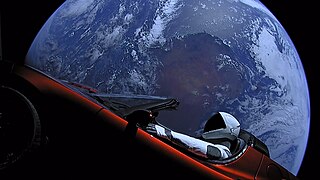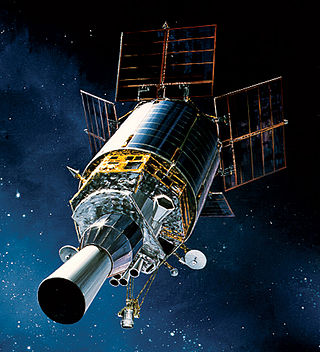The Geo-IK-2 is a Russian series of new generation military [1] geodesy satellites replacing the Soviet Union's Geo-IK [2] and Sfera [3] constellations. They are intended to be used to create high precision three-dimensional maps of the Earth's surface, and to monitor plate tectonics. The satellites are produced by ISS Reshetnev, and have a mass of around 1,400 kilograms (3,100 lb). [4] They operate in a circular orbit at an altitude of around 1,000 kilometres (620 mi) above the Earth's surface.
Not to be confused with the Napryazhenie / 14F150 / Nivelir military geodesy satellites. [5] [6]
| Designation | Launch date (GMT) | Carrier rocket | Orbit | Remarks |
|---|---|---|---|---|
| Geo-IK-2 #11 / Musson 2 #1 (Kosmos 2470) [4] | 1 February 2011 14:00 | Rokot/Briz-KM | Failed to enter usable orbit | Failure [7] |
| Geo-IK-2 #12 / Musson 2 #2 (Kosmos 2517) [4] | 4 June 2016 14:00 | Rokot/Briz-KM | 936 km × 961 km, 99.28° | Operational |
| Geo-IK-2 #13 / Musson 2 #3 (Kosmos 2540) [8] | 30 August 2019 14:00 | Rokot/Briz-KM | Originally planned on a Soyuz-2-1v, switched to a Rokot in June 2017. |

In satellite laser ranging (SLR) a global network of observation stations measures the round trip time of flight of ultrashort pulses of light to satellites equipped with retroreflectors. This provides instantaneous range measurements of millimeter level precision which can be accumulated to provide accurate measurement of orbits and a host of important scientific data. The laser pulse can also be reflected by the surface of a satellite without a retroreflector, which is used for tracking space debris.

Satellite geodesy is geodesy by means of artificial satellites—the measurement of the form and dimensions of Earth, the location of objects on its surface and the figure of the Earth's gravity field by means of artificial satellite techniques. It belongs to the broader field of space geodesy. Traditional astronomical geodesy is not commonly considered a part of satellite geodesy, although there is considerable overlap between the techniques.

This comparison of orbital launch systems lists the attributes of all individual rocket configurations designed to reach orbit. A first list contains rockets that are operational or in development as of 2022; a second list includes all retired rockets. For the simple list of all conventional launcher families, see: Comparison of orbital launchers families. For the list of predominantly solid-fueled orbital launch systems, see: Comparison of solid-fueled orbital launch systems.

Gonets is a Russian civilian low Earth orbit communications satellite system. It consists of a number of satellites, derived from Strela military communications satellites. The first two satellites, which were used to test and validate the system, were launched by a Tsyklon-3 launch vehicle from the Plesetsk Cosmodrome on 13 July 1992, and were designated Gonets-D. The first operational satellites, designated Gonets-D1, were launched on 19 February 1996. After launch, the first three satellites were given military Kosmos designations, a practice which was not continued with the other satellites.
Kosmos 2470, also known as Geo-IK-2 No.11, was a Russian geodesy satellite launched in 2011. The first Geo-IK-2 satellite, it was intended to be used to create a three-dimensional map of the Earth's surface, and to monitor plate tectonics. The satellite was produced by ISS Reshetnev, and has a mass of around 1,400 kilograms (3,100 lb). It was intended to operate in a circular orbit at an altitude of around 1,000 kilometres (620 mi) above the Earth's surface; however, it was placed into a lower than planned orbit after its launch failed.

In 2015, the maiden spaceflights of the Chinese Long March 6 and Long March 11 launch vehicles took place.

This article compares different orbital launcher families. The article is organized into two tables: the first table contains a list of currently active and under-development launcher families, while the second table contains a list of retired launcher families.

This article documents notable spaceflight events during the year 2019.

Notable spaceflight activities in 2017 included the maiden flight of India's Geosynchronous Satellite Launch Vehicle Mark III on 5 June and the first suborbital test of Rocket Lab's Electron rocket, inaugurating the Mahia spaceport in New Zealand. The rocket is named for its innovative Rutherford engine which feeds propellants via battery-powered electric motors instead of the usual gas generator and turbopumps.

This article documents notable spaceflight events during the year 2018. For the first time since 1990, more than 100 orbital launches were performed globally.

An early warning satellite is a satellite designed to rapidly detect ballistic missile launches and thus enable defensive military action. To do this, these satellites use infrared detectors that identify the missile thanks to the heat given off by its engines during the propulsion phase.

A small-lift launch vehicle is a rocket orbital launch vehicle that is capable of lifting 2,000 kg (4,400 lb) or less or under 5,000 kilograms (11,000 lb) of payload into low Earth orbit (LEO). The next larger category consists of medium-lift launch vehicles.

The KAUR program was a series of satellite buses designed and manufactured by ISS Reshetnev. Its design is based on a pressurized bus originally developed in the 1960s and has been used from low Earth Orbit to medium Earth orbit and even to GEO. It has four different generations and its different versions have been used from civilian communications to satellite navigation.

This article documents notable spaceflight events during the year 2020.

Sfera is a series of Soviet geodetic satellites.

This article documents expected notable spaceflight events during the year 2026.